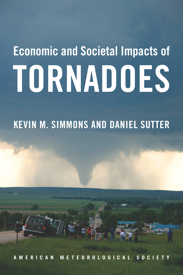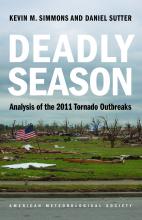Economic and Societal Impacts of Tornadoes
Latest News
Over the decades, AMS has championed the publication of unique textbooks and literature for the weather, water, and climate community, including enthusiasts. While AMS does not routinely accept book proposals, it has many books of lasting record--biographies, histories, guides, and textbooks--on offer through this bookstore as well as through the University of Chicago Press.
Shopping cart
There are no products in your shopping cart.
| 0 Items | $0.00 |
Information About:
Economic and Societal Impacts of Tornadoes
CHOICE review of Economic and Societal Impacts of Tornadoes
eBook available from Springer.
Use coupon code TORNCOMBO at checkout when you buy this and Deadly Season together and receive 15% off!
To see member pricing above, members should log in to the AMS Bookstore
Title information
Approximately 1,200 tornadoes touch down across the United States annually, and for almost a decade, economists Simmons and Sutter have been gathering data from sources such as NOAA and the U.S. Census in order to examine the casualties caused by tornadoes and to evaluate the National Weather Service's efforts to reduce these casualties.Approximately 1,200 tornadoes touch down across the United States annually, and for almost a decade, economists Simmons and Sutter have been gathering data from sources such as NOAA and the U.S. Census in order to examine the casualties caused by tornadoes and to evaluate the National Weather Service's efforts to reduce these casualties. Their unique database has enabled this fascinating and game-changing study of tornado impacts and how factors such as storm timing and warning lead time affect impacts; whether Doppler radar and shelters are worth the investment; and more. For meteorologists, social scientists, emergency managers, and everyone studying severe weather, policy, disaster management, or applied economics.
See Also: Deadly Season: Analysis of the 2011 Tornado Outbreaks
Buy together with Deadly Season: Analysis of the 2011 Tornado Outbreaks
Table of Contents
Chapter 1. What We Can Learn from Societal Impacts Analysis
Chapter 2. Tornado Climatology and Society's Tornado Risk
Chapter 3. An Analysis of Tornado Casualties
Chapter 4. Tornado Warnings: How Doppler Radar, False Alarms, and Tornado Watches Affect Casualties
Chapter 5. Sheltering from the Storm: Evaluating Tornado Shelters as a Mitigations Investment
Chapter 6. Property Damage and Community Impacts of Tornadoes
Chapter 7. Going Forward: Using Societal Impacts Research to Reduce Tornado Risk
Kevin M. Simmons
KEVIN M. SIMMONS is the Corrigan Chair of Economics at Austin College. In 2009 he was selected as a Fulbright Scholar to work with the International Center for Geohazards in Oslo. He holds a Ph.D. in Economics from Texas Tech University where he developed a research interest in the economics of natural hazards. His articles are widely cited and have appeared in journals from a variety of academic disciplines including engineering, sociology, law, and meteorology as well as economics.
Daniel Sutter
DANIEL SUTTER is professor of economics at the Sorrell College of Business at Troy University. He was formerly an associate professor of economics at the University of Texas—Pan American, and a senior affiliated scholar of the Mercatus Institute, where he has worked on their Hurricane Katrina project. Dr. Sutter’s research interests include the impact of weather hazards, the value of weather forecasts, the economics of the news media and news bias, and constitutional economics. His research on weather hazards has examined tornado casualties, the value of tornado shelters, hazards mitigation and the housing market, the determinants of societal vulnerability to hurricanes, and the value of hurricane forecasts.
Review of Economic and Societal Impacts of Tornadoes
CHOICE
Simmons (Austin College) and Sutter (Univ. of Texas-Pan American) analyze the cost-effectiveness of different measures for reducing the impact of tornados, including tornado shelters, safe rooms, warnings and watches, and Doppler weather radar. Starting with a fascinating discussion of the idiosyncrasies of tornado impact data, the book continues with a sophisticated analysis of casualty patterns and mitigation strategies. The analysis is authoritative and meticulously grounded in research; the topic is timely and important (not only because there seem to be more incidents of extreme weather, but also because of what the book reports about how people perceive and respond to low-probability, high-consequence events, so-called Black Swans); and the presentation is effective. The authors' research has important policy implications. For example, an increase in warning lead times beyond 15 minutes does not yield any additional reduction in tornado casualties; an increase in the number of false alarms increases casualties (the cry wolf effect) because people start ignoring warnings; and the value of protective investments depends on local risk factors, which vary by state and socioeconomic characteristics. This book will appeal mostly to readers with an interest in meteorological phenomena, which is a shame because it can be profitably read by a much broader audience. Summing Up : Highly recommended. All readership levels. -- J. H. Turek, Lynchburg College


